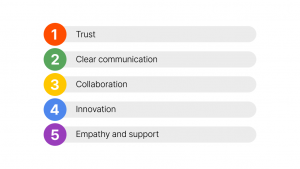Research is the pillar of an effective paper. It provides evidence for your message — thus, we have to be aware of the importance of managing our diverse range of research sources. However, the information we obtain from our research vary in format; articles, newsletters, videos, and more. Fortunately, our world has arrived at a point in which such information is digitalized, greatly increasing the accessibility of research information. Nonetheless, many students and business managers, especially those who document research-heavy papers, struggle to effectively manage their sources. So why is organization of research so important, and how can we achieve it effectively?
Why It’s Important to Manage and Organize Your Research Sources
Creating a reliable, well-made document requires a diversification of information from sources that come in several formats. Unfortunately, we lack practice in at least trying to manage this research, and thus we are overwhelmed by all this input of information. When writing, it’s difficult to process this information in a structural manner, crucial for writing the document. Soon enough, you find yourself staring at the screen trying to organize all this research in your brain. Before highlighting certain practices that help achieve effective research management, it’s important to realize why we should be doing it in the first place.
Structuring your Writing
A solid piece of writing follows a structure that allows the writer to logically order their content in order to best convey information and their ideas. Moreover, it makes it easy for readers to follow. That being said, having your resources scattered and inaccessible makes it difficult for you to structure your writing. Without the organization of research sources, you’ll soon find yourself confused and asking yourself the questions: “Where should I put this information? Wait. Where should I use this information?”. Organizing your research sources lays out a map for the path of your writing, and makes it easier to deliver your message to readers in a logical, convincing manner.
Many different types of structures exist today – nonetheless, the structure you follow depends on the type of writing you’re doing. Writer’s Digest lays out Six Logical Writing Structures that help build the bones of your creation. Considering that you have built the skeleton and pillars of your writing, it’s time to start researching information that you can integrate into your writing.
Integration: Research to Writing
By managing your resources, it makes the process of integrating the information to your writing much easier. You can initiate certain practices that help you transform data and information. For example, categorizing research sources can assist you in effectively transforming and compressing information into your writing. Research provides evidence for your writing, and thus effective integration helps you create a document of reliable information, with a touch of professionalism.
Saving Time
Saving time is crucial for writing, especially when you’re dealing with deadlines. In fact, we often find ourselves being chased by the pressure of time when writing certain documents, whether it be for academic or business purposes.
Writing long documents that require plenty of research and data can be difficult to write in a short period of time, and thus, when we take part in such long projects, we save our work and continue the progress some other day. The problem is that when we reopen a work-in-progress document, we often spend a bit of time trying to figure out the progress of the document, and at times, forget the context and information. Eventually we find ourselves looking through folders, and browsing through the internet trying to relocate previously used resources in order to refresh our memory and understanding of the context of information.
Fortunately, several tools do indeed exist, that help people work efficiently, and ultimately save time in their documentation process. By managing your research sources, you can save valuable time in relocating – and moreover, keep a steady level of understanding throughout the long-term writing process.
How to Manage your Research Sources
Our operating systems provide the traditionally, horizontal file system to organize our files. Whether it be our operating system, or any other digital platform and software, we have yet to reach a norm in which we begin to manage and organize research sources and information. Presently, the best we can do for saving our research by simply copy and pasting the URL of sources on a separate document, or saving them through our local files or online clouds. Fortunately, digital tools do indeed exist to help you with the process of saving, managing and organizing your research.
Use Digital Tools that Do the Work for You
As much as we heavily rely on documentation tools in our world today, there are several existing tools that can immensely help with the process of saving and managing your resources.
Bookmarks
All the internet browsers we utilize today provide a Bookmark function. You can save certain web pages that you want easy access to. The downside is that this bookmark isn’t too user-friendly, and it may be difficult to relocate bookmarks when you have too many. The downside of using bookmarks is that they lack user-friendliness: It’s difficult to relocate bookmarks when you have too many, and it doesn’t support bookmarking offline research sources such as documents, sheets and pdf files. Nonetheless, it provides a space in which we can store our research in one single location.
Typed
Everything mentioned can be achievable through our tool. Typed is the best resource management and organization tool you can find out there. Typed allows users to easily save both online and offline sources necessary for your research. By making your work environment easier and faster, enables you to concentrate your focus on pure creation.
The way Typed adopts organization of research into their software is unlike any other solution. Every resource that has been collected and stored on Typed’s network, can be assigned to a specific document. For an example, if you’re doing a research paper on analyzing economic change, you can have all articles, files and any form of resource stored within the workspace itself.
In order to ensure that users can focus on the context of their writing, Typed provides a unique, easy-to-use workspace in which you can view both your sources and the document simultaneously. Typed also provides a feature in which users can highlight important information on their research sources. If you’re looking for the perfect document writing tool for your heavy research, you can do it with ease through Typed.
Other Tools to Help Your Research
Other than Typed and Google’s Bookmark function, there are existing tools out on the web that may help you in achieving a few of the points I have mentioned before. Typed still is the best tool out there to successfully carry out all the necessary steps mentioned in order to achieve successful integration of your research, and ultimately become a better searcher, and writer. You can check out our post about the Top 5 Writing Tools That Will Save Students’ Time when Writing a Paper.



